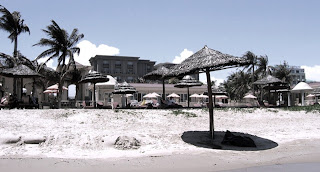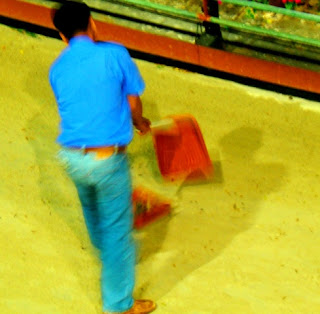In my last post, I talked about the looms and fabric production that is displayed on the first floor. The second half of the first floor covers costume and dress. After seeing the traditional fabrics being woven, we are also shown the dress made up.
You can still see the ethnic minorities who make these beautiful clothes dressed in the traditional garb in some places in Vietnam, and in other places around South East Asia too. Traditionally, many of the hill tribe populations were nomadic, so their customs of dress and skills as weavers and embroiderers followed them throughout the region.
Large numbers of the Cham ethnic minority who were responsible for building the breath-taking towers at My Son and other sites, converted to Islam after their final defeat by the Viet. They are not forgotten in the Women's Museum, and an example of their beautiful silk costume is on display.
There is also a really great example of a Chinese Wedding costume on display. Vietnam has at various times been under Chinese occupation, and so wedding costumes like this were in use in parts of Vietnam as recently as 150 years ago.
It is an extremely elaborate costume with silk tassels, embroidery, sequins and a headdress that looks so heavy I don't know how the poor girl would be able to hold her head up! I'm not sure about the exact provenance of this example, but given the expense and time that must have gone into one of these, I imagine that they would have been handed down between generations and added to or altered with each new bride.
The Vietnamese national costume that is still in use is the ao dai. In its current version it is a sleek, tight fitting tunic over loose-fitting trousers. The tunic has split sides from just below the bust down, leaving a little triangular peek of flesh above the waistline of the trousers. They are very commonly worn today - not just for special occasions at all. The girl who sits on reception in my apartment building wears one as part of her uniform.
I was really interested to learn about the history of the ao dai in the museum. It is a relatively modern national costume - I think it began to be worn about 250 years ago. And it is had undergone many small changes in that time. It is a fashion that changes rapidly, just as any other fashion does. At times, the tunic has been loose fitting, at times a cross over style, some times short, and sometimes long.
This example was made for a wedding in the early 20th century. It is much more loose fitting than the modern ones which tend to have raglan sleeves and cling tightly to the bust! Like the Chinese wedding costume it is lucky red, and has a headdress and collar that reaches over the bust - though it's much less extravagant!
I was really interested in the belt and armband. What are they made of? It is a row of glistening metallic green curved plates, sewn on to a strip of leather. This was made in a pre-plastic era, and while it's possible that it could be some kind of brilliant paint on metal moulded thingies - I think they look like wingcases of some kind of metallic insect. There is nothing written about it on display information, and there was no one around to ask. What do you think?























































